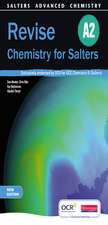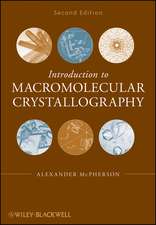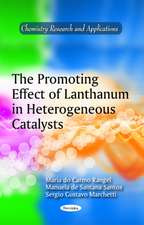Coordination Chemistry in Non-Aqueous Solutions
Autor Victor Gutmannen Limba Engleză Paperback – 28 feb 2012
Preț: 383.33 lei
Nou
Puncte Express: 575
Preț estimativ în valută:
73.36€ • 76.39$ • 61.100£
73.36€ • 76.39$ • 61.100£
Carte tipărită la comandă
Livrare economică 10-24 martie
Preluare comenzi: 021 569.72.76
Specificații
ISBN-13: 9783709181966
ISBN-10: 3709181968
Pagini: 184
Ilustrații: VIII, 174 p.
Dimensiuni: 170 x 244 x 10 mm
Greutate: 0.3 kg
Ediția:Softcover reprint of the original 1st ed. 1968
Editura: SPRINGER VIENNA
Colecția Springer
Locul publicării:Vienna, Austria
ISBN-10: 3709181968
Pagini: 184
Ilustrații: VIII, 174 p.
Dimensiuni: 170 x 244 x 10 mm
Greutate: 0.3 kg
Ediția:Softcover reprint of the original 1st ed. 1968
Editura: SPRINGER VIENNA
Colecția Springer
Locul publicării:Vienna, Austria
Public țintă
ResearchCuprins
I General.- 1. Introduction.- 2. Classification of Solvents.- 3. Physical Properties.- 4. Acids and Bases (Acidic and Basic Function).- 5. Techniques with Non-Aqueous Solvents.- II Principles of Coordination Chemistry in Non-Aqueous Solutions.- 1. Donor Solvents and Acceptor Solvents.- 2. Coordinating Properties of Solvents.- 3. Coordination Equilibria in Solution.- 4. Solvation and Donor Properties.- III Coordination Chemistry in Proton-containing Donor Solvents.- 1. General Properties of Proton-containing Solvents.- 2. Liquid Ammonia.- 3. Hydrazine.- 4. Hydrogen Sulphide.- 5. Formamide and Acetamide.- 6. Formic Acid and Acetic Acid.- 7. Alcohols.- IV Proton-containing Acceptor Solvents.- 1. Introduction.- 2. Hydrogen Fluoride.- 3. Liquid Hydrogen Chloride, Hydrogen Bromide and Hydrogen Iodide.- 4. Liquid Hydrogen Cyanide.- 5. Sulphuric Acid.- 6. Nitric Acid and Phosphoric Acid.- 7. Fluorospulphuric Acid, Chlorosulphuric Acid, Difluorophosphoric Acid and Disulphuric Acid.- V Proton-free Acceptor Solvents.- 1. Covalent Oxides.- 2. Covalent Fluorides.- 3. Covalent Chlorides.- 4. Covalent Bromides.- 5. Molten Iodine.- VI Oxyhalide Solvents.- 1. Oxyhalides with Low Donor Numbers.- 2. Oxyhalides with Medium Donor Numbers.- VII Certain Donor Solvents.- 1. 1,2-Dichloroethane (DNSbCl5 = 0.1).- 2. Nitromethane (NM) (DNSbCl5) and Nitrobenzene (NB) (DNSbCl5 = 4.4).- 3. Acetic Anhydride (AA) (DNSbCl5 = 10.5).- 4. Acetonitrile (AN) (DNSbci6 = 14.1).- 5. Sulpholane (Tetramethylenesulphone) (DNSbCl5 = 14.8).- 6. Propanediol-1,2-carbonate (PDC) (DNSbCl5 = 15.1).- 7. Acetone (DNSbCl5 = 17.0).- 8. Ethyl Acetate (DNSbCl5 = 17.1).- 9. Diethylether (DNSbCl5 = 19.2).- 10. Trimethyl Phosphate (TMP) (DNSbCl5 =23).- 11. Tributyl Phosphate (TBP) (DNSbCl5 = 23.7).- 12. Dimethylformamide (DMF) (DNSbCl5~27).- 13. N,N-Dimethylacetamide (DMA) (DNSbCl5 = 27.8).- 14. Dimethyl Sulphoxide (DMSO) (DNSbCl5 = 29.8).- 15. Hexamethylphosphoramide (HMPA) (DNSbCl5 = 38.8).- VIII Coordination Chemistry of Certain Transition Metal Ions in Donor Solvents.- 1. Iodide Ions as Competitive Ligands.- 2. Bromide Ions as Competitive Ligands.- 3. Chloride Ions as Competitive Ligands.- 4. Azide Ions as Competitive Ligands.- 5. Thiocyanate Ions as Competitive Ligands.- 6. Cyanide Ions as Competitive Ligands.- 7. An Attempt to Assign a Donor Number to Anions.- 8. Conclusion.







